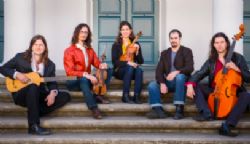|
Symphony
FROM THE NEW WORLD TO THE OLD WORLD
by Peter Lert
Saturday, June 14, 2025
Chamber
MC2 DUO RECITAL CLOSES 222'S SEASON
by Terry McNeill
Saturday, June 14, 2025
Choral and Vocal
CANTIAMO SONOMA'S LUSCIOUS A CAPELLA SINGING IN SEASON ENDING CONCERT
by Pamela Hicks Gailey
Sunday, June 8, 2025
Symphony
SRS SEASON ENDS WITH RESOUNDING TA-TA-TA-BANG
by Terry McNeill
Sunday, June 1, 2025
Symphony
YOUTHFUL VIRTUOSITY ON DISPLAY AT USO'S MAY CONCERTS
by Peter Lert
Saturday, May 17, 2025
Symphony
MYSTICAL PLANETS AND LIVELY GERSHWIN ORTIZ AT FINAL SRS CONCERT
by Peter Lert
Sunday, May 4, 2025
Symphony
VSO'S CONCERT MUSIC OF TIME, MUSIC OF PLACE
by Peter Lert
Sunday, April 27, 2025
VOCAL ELEGANCE AND FIRE AT THE 222'S RECITAL APRIL 26
by Pamela Hicks Gailey
Saturday, April 26, 2025
CANTIAMO SONOMA SINGS AN INSPIRED GOOD FRIDAY MOZART REQUIEM CONCERT
by Pamela Hicks Gailey
Friday, April 18, 2025
DRAMATIC SHOSTAKOVICH SYMPHONY CLOSES PHILHARMONIC'S 25TH SEASON
by Terry McNeill
Sunday, April 13, 2025
|
 |
 Agave Baroque Ensemble |
COLORFUL BORN BACH AT AGAVE BAROQUE'S SCHROEDER HALL CONCERT
by Sonia Morse Tubridy
Friday, February 28, 2020
Bach’s obituary records that “Johann Sebastian Bach belongs to a family that seems to have received a love and aptitude for music as a gift of Nature to all its members in common.” Agave Baroque presented their Feb. 28 concert, Born Bach, as a partial musical story of several generations in this remarkable family.
The telling commenced with a short lecture, presented with a great flair for humor by Henry Lebedinsky, as he told how the Bach family’s musical journey commenced with a refugee fiddler to Germany’s Thuringia, then Johann Christoph, Johann Michael (whose daughter Maria Barbara married Johann Sebastian) and on to Wilhelm Friedemann and Carl Phillip Emmanuel. The family tree is complex and fascinating, with important ties to Frederick the Great, Telemann, eventually even Mendelssohn and Schumann.
The Bachs, in more than five generations, created great works spanning German, Italian and new cosmopolitan musical styles. The giant figure of Johann Sebastian towers over all but he evolved and flourished in an environment shaped by those before him and continued to color the history of music through his gifted sons and their achievements.
Following the talk, the audience of 200 in Schroeder Hall waited with anticipation to hear Agave with their Baroque ensemble. Instead, lights dimmed and the awe inspiring tones of the pipe organ filled the hall with the E Flat Prelude and Fugue by Johann Christoph. This music was emotional, monumental and often tortured in its chromatic and dissonant complexity. This was a shocking and terrifying musical experience and gave context to J.S. Bach's organ works that followed generations later. The explosion of organ energy was followed by the members of Agave performing Johann Michael Bach’s Sonata and Capriccio a 4. This was a welcome contrast, with its sweet sounds being passed from one instrument to another, music of beauty and depth. Detailed phrasing by all the musicians, with the subtle tone colors of the variety of strings, was delightful. Johann Sebastian’s violin sonata with continuo featured an intricate and intelligently moving violin performance by Aaron Westman and exciting cello lines from William Skeen, beautiful string accompaniment by Kevin Cooper’s theorbo, and the magnificent harpsichord playing of Mr. Lebedinsky. The musical cameraderie pervading this Sonata was always evident, whether in sprightly dance rhythms, touching melodic lines or complex fugal worlds.
Next, Johann Christoph Friedrich’s Sonata in A brought a change of style, Italian Gallant, and featured lyrical viola and harpsichord duets. It is worth noting that Mr. Westman and Anna Washburn switched their violin and viola instruments frequently in this program, each contributing their individual mastery and tone qualities while playing with great attentiveness to the other’s parts. Completing the first half of the concert was Ouverture-Suite in G minor by Johann Bernhard Bach. Here we heard the French style with its pomp and formality. This composer was a student of Telemann and was immersed in the transitional styles of the period.
Following intermission the program consisted of two more extended works. First came. Bach’s Trio Sonata from the his Musical Offering. This work in four movements is one of Bach’s last and greatest achievements. There were introductory remarks about Johann Sebastian visiting his son C.P.E. Bach at the court of Frederick the Great and how the Musical Offering came about. Sensitive canons, complex counterpoint and harmony and even some of the “new” styles were included. Anchored by Mr. Skeen’s cello, the ensemble soared.
The concluding work was Trio Sonata in A minor by J.S. Bach’s eldest son Wilhelm Friedemann Bach. Much of his work was lost, so it was another gift of this concert to hear such a seldom performed composer. The composition was in five sections, a structure called cruciform, with symmetrical movements and a canonical middle movement.
There was much applause, then a standing ovation and bravos rewarded the Agave ensemble. In addition to introducing their instruments to the audience with interesting anecdotes, including Mr. Cooper’s baroque guitar, an encore was presented. This was a Bach pedagogical work, his role as teacher exemplified, where Bach had assigned a bass line from a violin sonata to one of his unnamed sons as a composition exercise.
|
